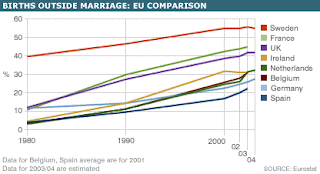In France, it was announced (see here in the NY Sun!) by INSEE, the Paris-based national statistics agency, that in 2007, for the first time, the number of babies born out of wedlock eclipsed 50% (hitting 50.5%). That sent me scurrying across the web to find comparative stats. I was not sure, but I assumed that France was not alone in that trend. And that is an understatement. The trend is international. And quite a statement on the plight of marriage, as well as on the state of society.
Here is what I found out.

In the UK, this BBC report from 2004 said that the rate in Britain had reached 42%. But it is Sweden that leads all EU countries with around 53% (see Eurostat graphic to right). Sweden (red line on top) was already at 52% in 1995. France (green line) has been the second highest in Europe since the mid-1980s. Some good info on this Demographic Blog, and a comprehensive recent post on Demography Matters.
In the US, per 2005 CDC Gov stats, the percentage is 36.9%. Who makes up that 37% is not easy to piece together. But, already on the immigration front, courtesy of the Center for Immigration site, I have the following details and quotes:
-
Hispanic immigrants have seen the largest increase in out-of-wedlock births — from 19 percent of births in 1980 to 42 percent in 2003. This is important because Hispanics account for nearly 60 percent of all births to immigrants.
-
In addition to the 42 percent rate for Hispanic immigrants, the illegitimacy rate is now 39 percent for black immigrants, 11 percent for Asian/Pacific Islanders, and 12 percent for white immigrants.
-
There’s no indication of improvement over the generations. Among natives, the illegitimacy rate is 50 percent for Hispanics; 30 percent for Asian/Pacific Islanders, and 24 percent for whites.
-
There is no evidence that illegitimacy is related to legal status. Illegitimacy is common in many immigrant-sending counties. According to the UN, in Mexico and Canada the illegitimacy rate is 38 percent; in El Salvador it’s 73 percent; and it’s 86 percent in Jamaica
Per this CITY, Hispanic Family Values article, there is clearly a lot of concern with regard this trend of births out of wedlock in the Hispanic community. And I quote from this article, “[E]very 1,000 unmarried Hispanic women bore 92 children in 2003 (the latest year for which data exist), compared with 28 children for every 1,000 unmarried white women, 22 for every 1,000 unmarried Asian women, and 66 for every 1,000 unmarried black women. Forty-five percent of all Hispanic births occur outside of marriage, compared with 24 percent of white births and 15 percent of Asian births. Only the percentage of black out-of-wedlock births—68 percent—exceeds the Hispanic rate.” This NPR podcast deals further with the situation for Black Americans.
Perhaps another area that deserves highlighting is the appallingly high number of teen births in the US. This article from Breitbart.com says the following:
“The birth rate among teenagers [in the U.S.] declined 2 percent in 2005, continuing a trend from the early 1990s. The rate is now about 40 births per 1,000 females ages 15 to 19. That is the lowest level in the 65 years for which a consistent series of rates is available. The U.S. teen birth rate is still the highest among industrialized countries.”
Looking at births out of wedlock, in general, the most critical issue may just be the existence of a loving couple to bring up that child. But between the high numbers of teen births and the high divorce rates, not to mention out-of-wedlock births, there is surely a new paradigm shift underway in terms of the composition of family. Apparently, Gen Yers are placing high(er) esteem on traditional values of family and are now looking for guidance and mentors. It would seem that there is a lot of work to be done on all fronts to create a successful concept/image of long-term marriage, new economic models and incentives and, above all, EDUCATION for what is, as far as teen and out-of-wedlock births are concerned, an over-weighted phenomenon in under-educated classes.











Excellent article.
Illegitimacy is irresponsible & should NOT be praised.